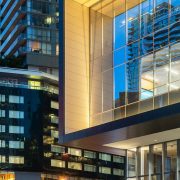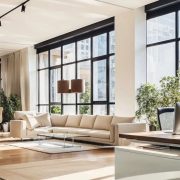Dynamic Workspaces Create Synergy
Dynamic workspaces infuse energy into an office through flexible, multi-functional spaces that encourage team collaboration. The design is focused on how each employee’s unique work style can flourish within a shared space. Successfully getting work done within multi-functional, well-designed spaces that can rapidly evolve has become the next-level hybrid office design challenge.
Dynamic design encourages a workspace environment with an open concept and flexible building elements. This flexibility, in turn, helps employees stay focused and productive throughout the day by shifting work areas. To move up to this next level, take a step back and consider how your workspace functions through the different lenses of your team structure. Strive for a more visually stimulating space for inspired collaboration, brand creation, and client immersion.
When office design becomes more dynamic, it creates a synergy between everyone involved. These highly creative spaces encourage thinking, working, and playing in collaboration. Creating a compelling office interior involves dialog across your teams to find the specific elements that foster deeper brand engagement. The goal is to make the work more meaningful, with enhanced performance at an optimal client-focused level. A charismatic design provides an environment that helps teams think creatively and develop innovative ideas that ultimately better serve the client.
Moving forward, office design has to be transformative and adaptable. Dynamic workspaces can be modified or reorganized at a moment’s notice, which allows the company to take advantage of new opportunities as they arise. Spaces should be able to multitask from a staff gathering to a video training session to a client exchange quickly and easily.
DYNAMIC WORKSPACE DESIGN
Incorporating dynamic design into your workplace plays a major part in creating a comfortable, successful work community where all workstyles can flourish. A dynamic workspace involves engaging the brand through savvy use of design elements to create unique brand storytelling with a fresh office design upgrade. If your business has a modern visual brand, make sure that energy continues into the physical environment. Observing and reacting to how employees and visitors interact with your office design can be a powerful experience for a redesign. This process can give you deep insight into client interaction and can help you more objectively view your office design and make improvements that make sense for your long-term goals.
Focus on a strong overall aesthetic that includes more custom interior design elements that tell your brand story. Reviewing the workspace as a unit can help you determine not only how your team utilizes the space, but it can also help you determine how the workspace as a whole looks and functions for different levels of usage. Pay close attention to these issues:
- Micro-Spaces: In a dynamic workspace, micro-spaces can look like a cafe coffee bar or a bank of high tables along a window wall wired for laptop usage. This provides a fresh approach compared to many small rooms filled with desks or cubicle walls that can affect productivity.
- Declutter: Oversized furniture in close quarters often feels cluttered and adds stress due to inflexibility. Dynamic furniture allows for more form and function with furnishings that can shift throughout the day or week as needed. Strive to create hubs within the open space that allow teams to decide according to tasks how they need the furniture to function for the task.
- Optimize Space Usage: Transforming an open concept into a hybrid office space may require redefining the overall design:
• Replace solid walls with demountable glass for quiet work with more daylight distribution.
• Notice where the blocks to collaboration are and work to mitigate them.
• Think dynamically about how the interaction of seating elements can benefit employees long-term.
• Establish an overall look that embodies your brand + work ethic as part of the aesthetic.
• Become more team-focused with fewer closed-off conference rooms and offices.
• Adapt a hybrid design that focuses on bold colors within smaller casual seating groups.
DYNAMIC DESIGN COMPONENTS
Dynamic workspaces embody an aesthetic that can adapt to any situation. Minimize closed-off spaces with glass walls. Keep the window walls available for open seating groups and dynamic elements like huddle spaces, training areas, team collaboration hubs, touchdown spaces, and privacy booths for phone calls. Design for multiple levels of use to all function simultaneously:
- FLEXIBLE DESIGN ELEMENTS:
• Opt for mobile furniture that can adapt and change as needed.
• Include height-adjustable desk hubs that allow teams to decide what works best for them.
• Allow for multi-use work areas that can adapt for daily team meetings, flexible workstations, or single desks. - MULTIFUNCTIONAL + MULTIPURPOSE:
• Flexible conference areas should easily shift from open to intimate meeting spaces.
• Loft-style sitting areas with sofas and a big-screen TV can provide casual teleconferencing on the fly.
• Unique curved couches can create multifunctional spaces for flex work, brainstorming, and impromptu client meetings. - MOVABLE PARTITIONS:
• Movable partition walls in combination with flexible furniture provide a highly functional setting.
• Provide for unencumbered mobility for flexible and solo work throughout the space.
• Partner unique seating with moveable boards that can be easily rearranged for huddles, brainstorming, or presentations. - OPEN FLOOR DESIGN
• Open concept designs are ideal for a larger amount of space to accommodate collaboration.
• Benching systems vs cubicles allow adaptable productivity for small work teams.
• Keep floor spaces as open as possible with plenty of room for people to move around.
• Develop unique branded client meeting areas with coffee + snacks that feel like a destination, not a breakroom.
• Incorporate sofa collaborative areas where employees can share ideas informally.
• Don’t forget bold statement art to create visual impact throughout the space and reinforce branding!
DYNAMIC = SHAPESHIFTING SPACES
With the modern workplace’s criteria continuing to evolve rapidly, dynamic workspaces are a non-negotiable requirement for companies looking to put their best foot forward in this new era of work. By replacing traditional, impersonal, and dense office layouts with an emerging dynamic design concept you are essentially futureproofing your office design. Think along these design lines:
- Reconfigurable and multi-purpose-driven design
- Diverse furniture groupings
- Uniform lighting grids
- Forward-thinking design elements that make your brand story memorable
A modular space that allows you to shapeshift your workspaces with ease and minimal cost implications as the workforce changes will be more cost-effective down the road. Having this innate flexibility is particularly valuable, not only to accommodate a wide variety of work-related needs but to provide leaders with the ability to meet evolving business priorities and employee expectations. A contemporary modular office today will keep you poised to develop a more edgy workspace in the future. Our design team is interested to hear your thoughts on dynamic workspaces!
 HYBRID OFFICE DESIGN is embracing work environments that promote flexible work options. Our team is equipped with a new scope of knowledge to help you adapt your existing workplace effectively to the needs of this new way of working and what it means for your team. Contact us at 512-448-3769 or experts@officefurniturenow.com
HYBRID OFFICE DESIGN is embracing work environments that promote flexible work options. Our team is equipped with a new scope of knowledge to help you adapt your existing workplace effectively to the needs of this new way of working and what it means for your team. Contact us at 512-448-3769 or experts@officefurniturenow.com











